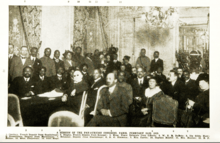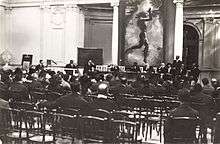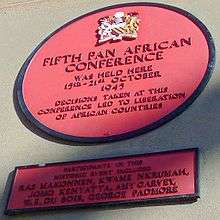Pan-African Congress
The Pan-African Congress — following on from the first Pan-African Conference of 1900 in London — was a series of eight meetings, held in 1919 in Paris (1st Pan-African Congress), 1921 in London (2nd Pan-African Congress), 1923 in London (3rd Pan-African Congress), 1927 in New York City (4th Pan-African Congress), 1945 in Manchester (5th Pan-African Congress), 1974 in Dar es Salaam (6th Pan-African Congress),[1] 1994 in Kampala (7th Pan-African Congress),[2][3] and 2014 in Johannesburg (8th Pan-African Congress)[4][5] that were intended to address the issues facing Africa as a result of European colonization of most of the continent.
The Pan-African Congress gained the reputation as a peace maker for decolonization in Africa and in the West Indies. It made significant advance for the Pan-African cause. One of the demands was to end colonial rule and end racial discrimination, against imperialism and it demanded human rights and equality of economic opportunity. The manifesto given by the Pan-African Congress included the political and economic demands of the Congress for a new world context of international cooperation.
Background
Colonial powers in Africa wanted native Africans to wait patiently for limited political concessions and better career opportunities. Due to their exclusion from the negotiations of the 1919 Treaty of Versailles — the most important of the peace treaties that brought World War I to an end — black ex-servicemen and educated urban classes became disillusioned. Because colonialism had been built on the foundation of capitalism, socialist ideas of equality and global collaboration appealed to these budding revolutionaries.
A letter from Jamaican writer and socialist Claude McKay to Leon Trotsky in 1922 refers to the experience of black soldiers:
They had been disillusioned with the European war, they kept on having frightful clashes with English and American soldiers, besides the fact the authorities treated them completely differently from the white soldiers... I was working at that time in London in a communist group. Our group provided the club of Negro soldiers with revolutionary newspapers and literature which had nothing.
1st Pan-African Congress

In February 1919, the first Pan-African Congress was organized by W. E. B. Du Bois and Ida Gibbs Hunt, wife of US Consul William Henry Hunt, who was at that time working at the American consulate in Saint-Étienne, France.[6] Gibbs and Du Bois were seen as ambassadors of Pan-Africa.[7] Also, Gibbs acted as the primary translator at the Congress.[7] There were 57 delegates representing 15 countries, a smaller number than originally intended because British and American governments refused to issue passports to their citizens who had planned on attending.[8] Their main task was petitioning the Versailles Peace Conference held in Paris at that time. Among their demands were that:
- The Allies should be in charge of the administration of former territories in Africa as a Condominium on behalf of the Africans who were living there.
- Africa be granted home rule and Africans should take part in governing their countries as fast as their development permits until at some specified time in the future.
Delegates
Among the delegates were:[9]
- Eliezer Cadet, Universal Negro Improvement Association
- Gratien Candace, Guadeloupe
- Blaise Diagne, Senegal, and French Commissioner General of the Ministry of Colonies
- William Jernagin, Washington, United States
- Charles D. B. King, Liberia
- Richard R. Wright
- Robert Russa Moton
2nd Pan-African Congress

In 1921, the Second Pan-African Congress met in several sessions in London, Brussels and Paris, during August (28, 29, and 31) and September (2, 3, 5 and 6).[10] As W. E. B. Du Bois reported in The Crisis in November that year, represented at this congress were "26 different groups of people of Negro descent: namely, British Nigeria, Gold Coast and Sierra Leone; the Egyptian Sudan, British East Africa, former German East Africa; French Senegal, the French Congo and Madagascar; Belgian Congo; Portuguese St. Thomé, Angola and Mozambique; Liberia; Abyssinia; Haiti; British Jamaica and Grenada; French Martinique and Guadeloupe; British Guiana; the United States of America, Negroes resident in England, France, Belgium and Portugal, and fraternal visitors from India, Morocco, the Philippines and Annam."[11] There was an Indian revolutionary who took part, Shapurji Saklatvala, and a journalist from the Gold Coast named W. F. Hutchinson who spoke. This session of the Congress was the most focused for change of all the meetings thus far. At the London session, resolutions were adopted, later restated by Du Bois in his "Manifesto To the League of Nations":[12][13]
England, with all her Pax Britannic, her courts of justice, established commerce, and a certain apparent recognition of Native laws and customs, has nevertheless systematically fostered ignorance among the Natives, has enslaved them, and is still enslaving them, has usually declined even to try to train black and brown men in real self-government, to recognise civilised black folk as civilised, or to grant to coloured colonies those rights of self government which it freely gives to white men.
The only dissenting voices were these of Blaise Diagne and Gratien Candace, French politicians of African and Guadeloupian descent, who represented Senegal and Guadeloupe in the French Chamber of Deputies. They soon abandoned the idea of Pan-Africanism because they advocated equal rights inside the French citizenship and thought the London Manifesto declaration too dangerously extreme.
The Brussels sessions were hosted at the Palais Mondial.[14]
3rd Pan-African Congress
In 1923, the Third Pan-African Congress was held in London and in Lisbon. This meeting was totally unorganized. This meeting also repeated the demands such as self-rule, the problems in the Diaspora and the African-European relationship. The following was addressed at the meeting:
- The development of Africa should be for the benefit of Africans and not merely for the profits of Europeans.
- There should be home rule and a responsible government for British West Africa and the British West Indies.
- The Abolition of the pretension of a white minority to dominate a black majority in Kenya, Rhodesia and South Africa.
- Lynching and mob law in the US should be suppressed.
Before the Congress met in London, Isaac Béton of the French Committee wrote a letter to Du Bois, telling him that the French group would not be sending delegates. However, in one of the reports he published in the Crisis, Du Bois drew on words spoken by Ida Gibbs Hunt and Rayford Logan to imply that the French Committee had sent delegates. As long-time African-American residents of France, Hunt and Logan had travelled independently to the meeting, and Hunt and Béton were perturbed that Du Bois had implied they represented France.[15]
4th Pan-African Congress
In 1927, The Fourth Pan-African Congress was held in New York City and adopted resolutions that were similar to the Third Pan-African Congress meetings.[16]
5th Pan-African Congress

The Fifth Pan-African Congress was held in Manchester, United Kingdom, from 15–21 October 1945. It followed the foundation of the Pan-African Federation in Manchester in 1944.[17] The Congress took place at the Chorlton-upon-Medlock Town Hall, which was decorated with the flags of the Republic of Haiti, Ethiopia, and Liberia, the only three independent black nations in 1945.[18] The Fifth Congress is widely viewed as the most significant, being held just months after the end of the Second World War. The war had been fought in the name of freedom, however around the globe, millions of Africans and Afro-Diaspora populations lived under European colonial rule.
Historian Christian Høgsbjerg writes in his essay Remembering the Fifth Pan African Congress that the aftermath of WWII gave rise to a "new mood of militancy among colonial Africans, Asians and West Indians."[19] According to Høgsbjerg, many felt betrayed after being promised movement towards self-government if they fought for the British and French empires during the First World War - only to have such promises later denied. Høgsbjerg writes that "many were determined not to be fooled again".[19] The Congress made demands for Independence as well as condemning imperialism, racial discrimination, and capitalism.[20]
Delegates
Organised by the influential Trinidadian pan-Africanist George Padmore and Ghanaian independence leader Kwame Nkrumah, the Fifth Pan-African Congress was attended by 200 attendants, with 87 delegates representing fifty organisations.[19] The Fifth Congress was unique in comparison to the four earlier Congresses as it was attended by delegates from Africa and across the African Diaspora, such as Afro-Caribbean’s, African American’s, and Black Briton’s.[21] South Asian activists Surat Alley and T. Subasingha were also in attendance at the conference[19].Delegates included scholars, intellectuals and political activists who would later go on to become influential leaders in various African independence movements and American civil rights movements. This was also the first time representatives from African and West Indian political parties were in attendance at the Congress.[22]
Historian Saheed Adejumobi writes in The Pan African Congresses, 1900-1945 that the Fifth Congress was dominated in majority by delegates from Africa and Africans working or studying in Britain.This was in contrast to previous Congresses that had been controlled largely by black middle-class British and African American Intellectuals. Adejumobi writes that the support of African workers, trade unionists and politicians gave way to radical social, political, and economic demands.[22]
The presence of 77-year-old W. E. B. Du Bois was historic, as he had organized the First Pan-African Congress in 1919.
Among the delegates were:
- Jomo Kenyatta, Kenya
- W. E. B. Du Bois, United States
- Hastings Banda, Malawi
- Kwame Nkrumah, Ghana
- Dudley Thompson, Jamaica
- Obafemi Awolowo and Jaja Wachuku, Nigeria
- Len Johnson, Britain
- Peter Abrahams, South Africa
- Amy Ashwood Garvey, Jamaica
Issues addressed
Amongst the issues addressed at the conference were[21]:
- The Colour Problem in Britain
- Imperialism in North and West Africa
- Oppression in South Africa
- The Problem in the Caribbean
- Women in the West Indies
It also led partially to the creation of the Pan-African Federation, founded in 1946 by Nkrumah and Kenyatta.
Reception
The British Press scarcely mentioned the conference. However, Picture Post covered the 5th Pan African Congress in an article by war reporter Hilde Marchant, ‘Africa Speaks in Manchester’ published 10 November 1945. Picture Post was also responsible for sending John Deakin to photograph the event.[23]
Archives
Documents, photographs and recorded testimonies that relate to the 5th Pan African Congress are held at the Ahmed Iqbal Ullah Race Relations Resource Centre at Manchester Central Library.
The Working Class Movement Library holds original records and documents from the 5th Pan African Congress.
The significance of the Pan-African movement and the Fifth Congress
Pan-Africanism is aimed at the economic, intellectual and political cooperation of the African countries. It demands that the riches of the continent be used for the enlistment of its people. It calls for the financial and economic unification of markets and a new political landscape for the continent. Even though Pan-Africanism as a movement began in 1776, it was the fifth Pan-African congress that advanced Pan-Africanism and applied it to decolonize the African continent.[24]
The people in Manchester were politically conscious and that was one of the reasons why it was selected as the venue for the fifth Pan-African congress. The fifth congress was organized by people of African origin living in Manchester. According to the Mancunian historian Simon Katzenellenboggen it has a great significance as it was an important step towards the end of those imperial powers in Africa. Unlike the four earlier congresses, the fifth one involved people from the African Diaspora, including Afro-Caribbeans and Afro-Americans. Manchester had a significant part to play in helping the African countries to march forward in their fight to independence.[21]
References
- Hill, Sylvia (2007), "From the Sixth Pan-African Congress to the Free South Africa Movement", in William Minter, Gail Hovey, and Charles Cobb Jr. (eds), No Easy Victories: African Liberation and American Activists over a Half Century, 1950–2000, Trenton, New Jersey: Africa World Press.
- Guest Editor's Introduction (June 1996), "Rebuilding The Pan African Movement, A Report on the 7th Pan African Congress", African Journal of Political Science. New Series Vol. 1, No. I.
- Essack, Karrim (11 May 1994), "The 7th Pan-African Congress in Perspective". Global Pan African Movement, 10 October 2012.
- Horne, David L. (30 January 2014), "A Pan African Step Forward", Our Weekly (Los Angeles).
- Bunsee, Benny (24 January 2014), "Arabs and the West must pay for slavery, says Pan-African Congress", Mail & Guardian.
- Roberts, Brian (2013). Artistic Ambassadors: Literary and International Representation of the New Negro Era. Charlottesville: University of Virginia Press. pp. 121–22.
- Dunstan, Sarah C. "CONFLICTS OF INTEREST: The 1919 Pan-African Congress and the Wilsonian Moment." Callaloo, vol. 39, no. 1, 2016, pp. 133-150,234. ProQuest, https://login.ezproxy.auctr.edu:2050/login?url=https://search-proquest-com.ezproxy.auctr.edu/docview/1790184012?accountid=8422.
- Painter, Nell Irvin (2008). Standing at Armageddon: A Grassroots History of the Progressive Era. New York: W.W. Norton & Company. p. 355. ISBN 978-0-393-33192-9.
- Worley, H. F., and C. G. Contee (April 1970), "The Worley Report on the Pan-African Congress of 1919", reproduced in Journal of Negro History, Vol. 55, No. 2, pp. 140–43.
- The Crisis, Vol. 23, No. 1 (November 1921).
- "Manifesto to The League of Nations", The Crisis, Vol. 23, No. 1 (November 1921), p. 18.
- Lewis, David, W. E. B. Du Bois: A Biography, 2009, pp. 414–15.
- Du Bois, W. E. B. , "To the World (Manifesto to The League of Nations.)", Opinion, The Crisis, Vol. 23, No. 1 (November 1921), p. 7.
- Kirschke, Amy (2004). "Du Bois, The Crisis and Images of Africa and the Diaspora". In Benesch, Klaus; Geneviève Fabre (eds.). African Diasporas in the New and Old Worlds: Consciousness and Imagination edited by. Rodopi. p. 246. ISBN 9042008806.
- Roberts, Brian Russell (2013). Artistic Ambassadors: Literary and International Representation of the New Negro Era. Charlottesville: University of Virginia Press. pp. 125–126.
- "The Pan-African Vision". The Story of Africa: Between World Wars (1914–1945). BBC News. Retrieved 16 April 2008.
- Adi, Hakim (2009), "George Padmore and the 1945 Manchester Pan-African Congress", in Baptiste, Fitzroy, and Rupert Lewis (eds), George Padmore: Pan-African Revolutionary. Kingston, Jamaica: Ian Randle Publishers.
- "1945 Pan-African Congress in Manchester".
- Christian, Høgsbjerg. "Remembering the Fifth Pan-African Congress".
- "Details on the Fifth Pan-African Congress and Pan-African Film Installation (London)".
- "It began in Manchester — Manchester and The Pan-African Movement". BBC News; Black History Month. 14 October 2005.
- Adejumobi, Saheed (30 July 2008). "The Pan-African Congresses, 1900-1945". Retrieved 13 May 2020.
- "The Pan-African Congress in black and white". www.newstatesman.com. Retrieved 15 May 2020.
- Pheko, Motsoko (15 November 1999). "Road to Pan-Africanism". The Sowetan.
External links
| Wikimedia Commons has media related to Pan-African Congress. |
- SNCC Digital Gateway: Organizing 6PAC Digital documentary website created by the SNCC Legacy Project and Duke University, telling the story of the Student Nonviolent Coordinating Committee & grassroots organizing from the inside-out
- "Remembering the Fifth Pan-African Congress" - Christian Høgsbjerg, Leeds African Studies Bulletin, 77 (2015–16).
- B. F. Bankie, "The 'Key Link' – some London notes towards the 7th Pan-African Congress", Ghana Nsem, 2001.